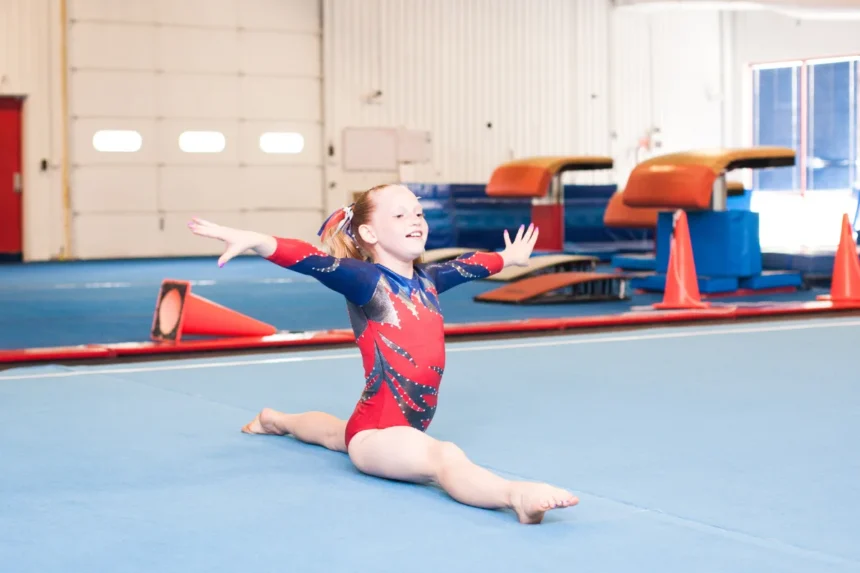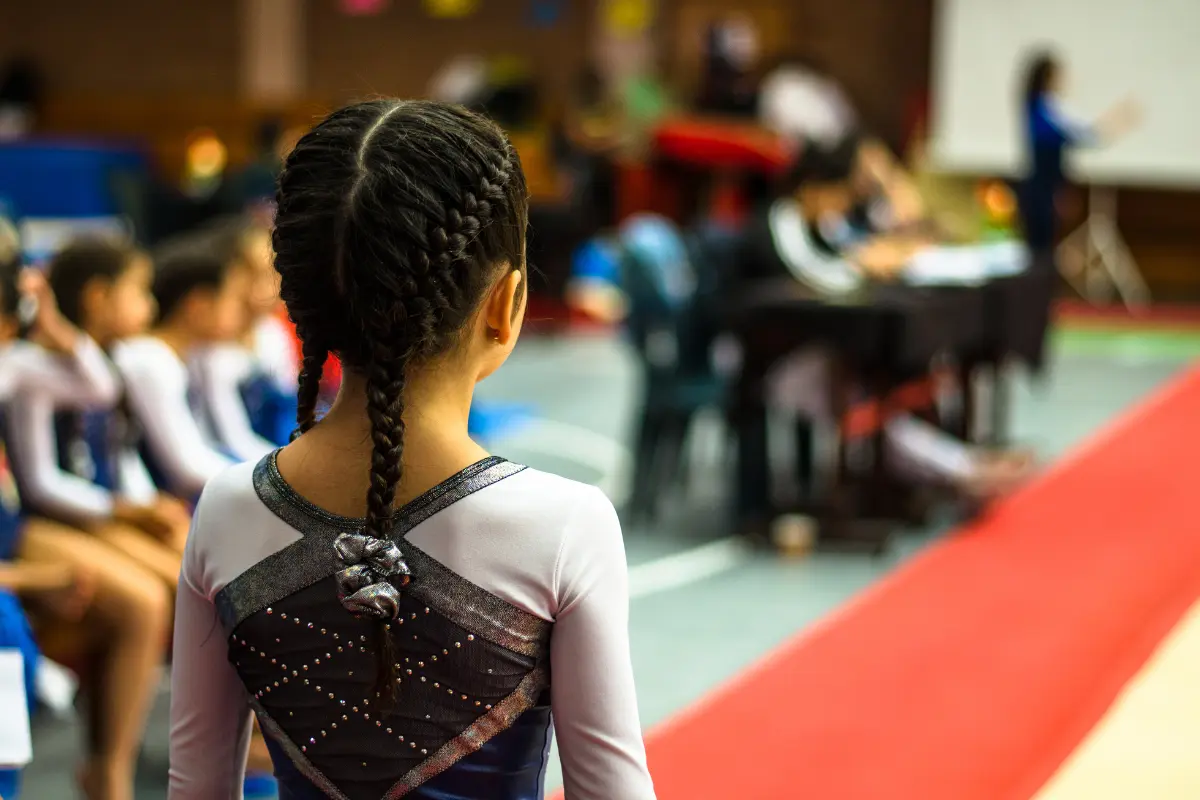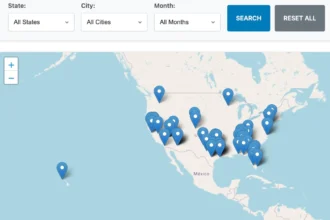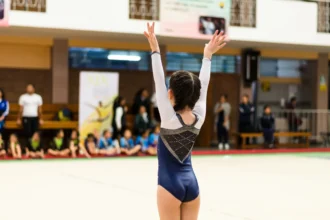In women’s artistic gymnastics, the floor routine stands out as one of the most dynamic and artistic events. It combines acrobatic skills, dance, and choreography, all of which are judged according to the FIG Code of Points.
This guide will walk you through the floor skill requirements for Levels 1 through 5, highlighting the essential elements that gymnasts must perfect as they progress through each level.
Level 1 Floor Routine Requirements
At Level 1, the focus is on developing basic floor skills, body awareness, and simple choreography. Gymnasts are introduced to the concepts of connecting movements smoothly and performing basic acrobatic skills in a controlled manner.
Key Elements:
- Forward Roll: A fundamental acro skill in gymnastics, the forward roll teaches gymnasts to move through the space safely while maintaining control and proper body alignment.
- Backward Roll: Similar to the forward roll, this skill is essential for developing body awareness and balance as gymnasts learn to rotate backward.
- Cartwheel: The cartwheel is one of the first tumbling skills that gymnasts learn. It involves a lateral rotation of the body while keeping arms and legs extended.
- Candlestick: This skill requires gymnasts to roll into a tucked position and then come up to a kneeling position in a smooth, controlled manner.
- Split Jump: A basic dance element that focuses on flexibility and the ability to jump and split the legs into a 180-degree split while in mid-air.
- Pose–T–Point: A choreography element that teaches gymnasts how to use their arms and legs effectively to create clean, sharp positions. The arms travel from behind the back to a “T” position and then extend overhead to a “Point” shape.
Performance Flow:
Level 1 floor routines are relatively simple, with gymnasts focusing on clear, clean movements. The routine should show smooth transitions between elements, and the gymnast should perform each skill at a controlled speed, emphasizing form and accuracy. The floor music is slower, helping gymnasts to focus on their technique rather than speed.
➡️ Recommended Level 1 Floor Routine
Level 2 Floor Routine Requirements
At Level 2, gymnasts begin to incorporate more complex acrobatic skills and slightly faster choreography. There is a greater emphasis on linking skills together and creating a flowing routine that showcases both technical and artistic abilities.
Key Elements:
- Forward Roll to Straddle Sit: A continuation from Level 1, this skill teaches the gymnast to transition smoothly from a forward roll into a straddle position.
- Backwards Roll to Bridge: Gymnasts now incorporate a bridge after a backward roll, adding an element of flexibility and strength to their routine.
- Round-off: A fundamental tumbling skill, the round-off prepares gymnasts for more advanced tumbling passes in future levels.
- Split Leap: The gymnast leaps into the air, aiming to achieve a split position with their legs. This leap requires flexibility, timing, and control.
- Choreographed Poses: At Level 2, gymnasts are expected to link poses together more creatively, using arm movements and leg positions that complement their skills.
Performance Flow:
Level 2 routines still focus on the connection of basic elements but with slightly more complexity. Gymnasts should demonstrate better control of their body and a stronger understanding of choreography. The routine music increases in tempo, allowing gymnasts to perform slightly quicker movements.
➡️ Recommended Level 2 Floor Routine
Level 3 Floor Routine Requirements
By Level 3, gymnasts are beginning to show more dynamic movements and acrobatic skills. Routines now have more sophistication, and the inclusion of acro skills that require more strength and coordination is necessary.
Key Elements:
- Round-off Back Handspring: A combination of two key acro elements, this skill marks the transition to more advanced tumbling. The gymnast performs a round-off followed by a back handspring.
- Front Handspring: A required acro skill that involves launching forward into a handstand before landing in a standing position. It emphasizes balance, control, and strength.
- Aerial Cartwheel: A more advanced version of the cartwheel where the gymnast does not touch the ground with their hands, demonstrating strength and control in the air.
- Jump with 180-degree Split: A jump requiring a high split in mid-air, with the legs fully extended. It shows flexibility and precision.
- Back Extension Roll: A transitional element where the gymnast rolls backward, but with their body extended in a straight line, adding an element of skill and strength.
Performance Flow:
At Level 3, the routines start to look more like optional-level performances, with gymnasts showcasing their acrobatic and artistic abilities more fully. The choreography is more complex, and gymnasts need to demonstrate better fluidity and precision. The music tempo increases slightly, adding to the excitement of the routine.
➡️ Recommended Level 3 Floor Routine
Level 4 Floor Routine Requirements
At Level 4, the gymnastics community expects gymnasts to demonstrate a wider variety of skills. The acro requirements become more difficult, and the artistry of the routine plays a larger role in scoring.
Key Elements:
- Round-off Back Handspring Series: Gymnasts must perform multiple round-offs and back handsprings, linking them together in a fluid, controlled sequence.
- Front Tuck or Front Layout: A forward somersault is required, showing both acrobatic skill and aerial awareness.
- Tumbling Pass Combinations: Gymnasts must demonstrate the ability to combine different tumbling passes together, showing power, strength, and control.
- Leap with 180-degree Split: The leap continues to be an important element, and at this level, gymnasts are expected to show more height and precision in their split.
- Choreographic Flourishes: At this level, the gymnast’s choreography becomes more sophisticated, and they are expected to show expression and artistic timing in their movements.
Performance Flow:
Level 4 routines are fast-paced, and gymnasts must show more advanced technical execution, incorporating multiple tumbling passes with stronger choreography. The floor music is upbeat, and gymnasts must execute each skill with power and precision while maintaining artistic expression throughout the routine.
➡️ Recommended Level 4 Floor Routine
Level 5 Floor Routine Requirements
By Level 5, gymnasts are performing advanced acrobatic skills and are increasingly expected to execute with precision and artistry. The routines are more personalized, and gymnasts are required to show a combination of power, skill, and creativity.
Key Elements:
- Round-off Back Handspring Back Tuck: A more advanced tumbling pass that involves two back handsprings followed by a back tuck.
- Front Handspring to Front Tuck: This pass combines a front handspring with a front tuck, showing both strength and acrobatic ability.
- Back Handspring Series: More complex series of back handsprings that demonstrate fluidity, strength, and flexibility.
- Switch Leap: This leap involves the gymnast performing a 180-degree split leap while turning in mid-air.
- Artistic Expression: Gymnasts are expected to demonstrate complete control over their movements, using facial expressions, arm positions, and dance elements to create a routine that flows from one skill to the next seamlessly.
Performance Flow:
Level 5 routines are marked by an increase in complexity, speed, and difficulty. Gymnasts are now ready for optional routines and are expected to perform with high-level technique, fluidity, and artistry. The tempo of the music increases, and gymnasts are expected to express their individuality and personality through their choreography.
➡️ Recommended Level 5 Floor Routine
| Skill | Level 1 | Level 2 | Level 3 | Level 4 | Level 5 |
|---|---|---|---|---|---|
| Forward Roll | ✔ | ✔ | ✔ | ✔ | ✔ |
| Backward Roll | ✔ | ✔ | ✔ | ✔ | ✔ |
| Cartwheel | ✔ | ✔ | ✔ | ✔ | ✔ |
| Round-off | ✔ | ✔ | ✔ | ✔ | |
| Back Handspring | ✔ | ✔ | ✔ | ||
| Front Handspring | ✔ | ✔ | ✔ | ||
| Front Tuck | ✔ | ✔ | |||
| Aerial Cartwheel | ✔ | ✔ | |||
| Back Handspring Series | ✔ | ✔ | |||
| Round-off Back Handspring | ✔ | ||||
| Front Layout | ✔ | ||||
| Split Leap | ✔ | ✔ | ✔ | ✔ | ✔ |
| Jump with Split (180°) | ✔ | ✔ | ✔ | ✔ | |
| Switch Leap | ✔ | ||||
| Choreographed Poses | ✔ | ✔ | ✔ | ✔ | ✔ |
| Artistic Expression | ✔ | ✔ |
Key Observations:
- Level 1 focuses on basic skills like rolls, cartwheels, and simple choreography, with an emphasis on form and control.
- Level 2 adds the round-off and more choreography, making the routine flow better.
- Level 3 introduces harder tumbling, like back handsprings and front handsprings.
- Level 4 combines skills like back handspring series and dynamic jumps like the switch leap.
- Level 5 includes advanced tumbling passes and acrobatic skills, like multiple back handsprings and front layouts.
Each level builds on the last, getting more challenging and helping gymnasts improve control, precision, and creativity for optional routines at Level 5.
Source: usagym.org






